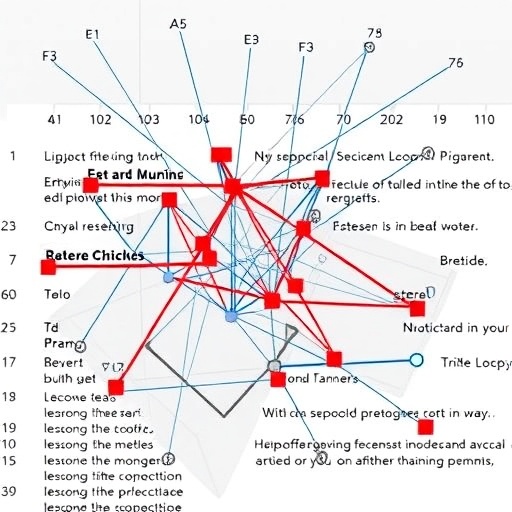Recent research conducted by A. Verkerk, O. Shcherbakova, and H.J. Haynie has uncovered profound insights into the enduring constraints that shape human grammar. This groundbreaking study employs innovative Bayesian spatiophylogenetic analyses, allowing a more nuanced understanding of how linguistic structures develop and evolve over time. The research highlights the interplay between evolutionary dynamics and language formation, offering fresh perspectives on a long-standing debate in the fields of linguistics and cognitive science.
At the core of this study lies the investigation into the genetic and environmental factors that influence the complexity and diversity of grammar across different languages. By utilizing advanced statistical modeling techniques, the researchers were able to analyze vast datasets that span various linguistic systems. This approach enabled them to trace the historical development of grammatical structures and identify patterns that have persisted throughout human history.
The research reveals that grammatical constraints are not merely random occurrences or cultural artifacts; rather, they are deeply rooted in our cognitive architecture and evolutionary past. The Bayesian spatiophylogenetic analyses employed in this study allow scientists to reconstruct the evolutionary pathways of language and grammar. This methodology integrates both phylogenetic data and linguistic features, which helps to elucidate the relationships between different languages and their respective grammatical systems.
One of the most striking findings is the patterns of grammatical similarity observed among languages that are otherwise geographically and culturally distinct. This suggests a shared evolutionary pathway, indicating that certain grammatical features may have emerged as adaptive responses to similar communicative needs, regardless of cultural background. This challenges the notion that language operates in isolation, reinforcing the idea that our linguistic capabilities are shaped by universal cognitive constraints.
The ability to analyze linguistic data in conjunction with biological data through evolutionary frameworks represents a significant advancement in the field. The researchers found that grammatical constraints appear to be under selective pressure, much like physical traits in evolutionary biology. This realization prompts a re-evaluation of the development of language as a natural phenomenon that is intertwined with our biological and cognitive evolution.
Further analysis indicated that the constraints identified can predict grammatical structures in languages that have not yet been thoroughly documented. This predictive power underscores the significance of understanding grammatical constraints, as it could lead to discovering new languages and dialects that conform to these trends. Thus, the implications of this research reach far beyond theoretical linguistics; they hold potential applications in fields such as linguistics documentation and artificial intelligence.
The urgency of understanding grammar’s constraints is amplified by the language extinction crisis; many languages are disappearing at an alarming rate. Understanding the underlying factors that shape grammar may offer critical insights into how languages evolve and adapt. It could also assist in developing strategies for language preservation, ensuring that linguistic diversity is maintained for future generations.
Moreover, the study’s findings may influence our comprehension of how children acquire language. By revealing that certain grammatical structures appear to have a biological basis, the research supports theories that suggest children are predisposed to learn languages following these innate constraints. This could lead to more effective methodologies in teaching and learning languages, tailoring educational approaches that align with our biological capacities.
As the study champions the idea of grammar constraints as a foundational aspect of language, it invites further interdisciplinary exploration. Linguistics, cognitive science, and anthropology can converge to develop a holistic understanding of human language as a phenomenon shaped by both our cognitive architectures and our evolutionary trajectories. This convergence could illuminate the shared characteristics of human communication and the distinct pathways various languages have taken.
The implications of such research also extend to the technology sphere, particularly in natural language processing (NLP) and artificial intelligence (AI). AI language models, which often struggle with nuanced grammatical rules, might benefit from insights into these enduring constraints. By integrating the principles of grammar revealed by this research, AI systems could be refined to generate more human-like responses, enhancing their utility and effectiveness across various applications.
The study, published in Nature Human Behaviour, is scheduled to influence not only academic circles but also the public perception of language and its origins. By framing grammar as an integral part of our biological and evolutionary makeup, it bridges the gap between abstract language theory and tangible human connections. The ability to communicate effectively is one of our most distinguishing features as a species, and understanding its mechanics can help us appreciate the delicate balance between our past and our present linguistic capabilities.
In summary, the research on enduring constraints on grammar emphasizes the need to recognize language as a complex interplay of biological, cognitive, and cultural factors. By employing Bayesian spatiophylogenetic analyses, the authors have shed light on the intricate pathways that language and grammar navigate through history, challenging conventional thinking and inviting new inquiries into the nature of human communication. As linguists, cognitive scientists, and AI researchers explore these new findings, the potential for greater understanding—and potential applications—of language continues to grow, promising exciting advancements in both research and real-world communication.
Research continues to unfold in this essential field, with the insights gained from Verkerk, Shcherbakova, and Haynie’s work paving the way for future explorations into the origins and evolution of human language. The unfolding narrative of linguistic studies resonates profoundly with our identity, our history, and the intricate web of connections that unites humanity through the shared gift of language.
Subject of Research: Constraints on grammar as revealed by Bayesian spatiophylogenetic analyses.
Article Title: Enduring constraints on grammar revealed by Bayesian spatiophylogenetic analyses.
Article References:
Verkerk, A., Shcherbakova, O., Haynie, H.J. et al. Enduring constraints on grammar revealed by Bayesian spatiophylogenetic analyses.
Nat Hum Behav (2025). https://doi.org/10.1038/s41562-025-02325-z
Image Credits: AI Generated
DOI: https://doi.org/10.1038/s41562-025-02325-z
Keywords: grammar, Bayesian analyses, spatiophylogenetics, language evolution, linguistic constraints, cognitive science.




